Drying lavender is a wonderful way to preserve your harvest. Learn all about how to dry lavender, including the best variety to use, and when to cut it. Plus I’ll give you step-by-step instructions for five different methods to try, and tips for storing it.
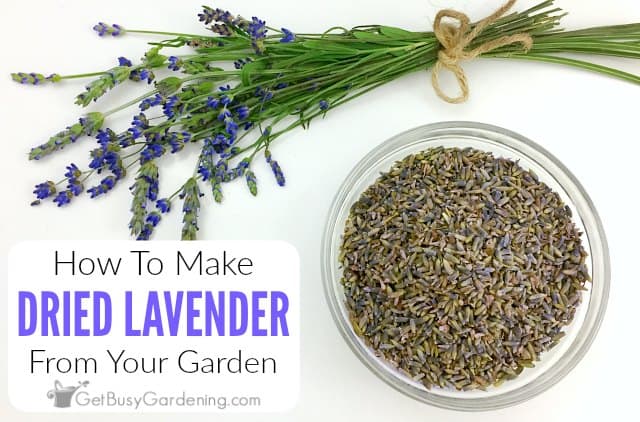
Lavender is a beautiful flowering herb that is well known for its calming fragrance and beneficial essential oils.
If you’re growing lavender in your garden, you can easily make your own DIY dried buds.
There are so many wonderful uses for it too. It’s excellent for making tea, cooking and baking, crafting, making sachets, and tons of DIY beauty products.
And guess what… it is really easy, and doesn’t take much time or effort. Win, win! In this guide you’ll learn all about how to dry your homegrown lavender.
What Part Of Lavender Do You Dry?
You can dry any part of the plant. However, the flower buds are the most popular, because they have the highest concentration of essential oils. Which means they’re more fragrant and flavorful.
But the leaves are edible and fragrant too, and there are lots of great uses for them in cooking and crafting.
So, you might want to try drying the leaves and sprigs of the stems too.
Related Post: 6 Ways To Dry Herbs The Right Way
Best Lavender For Drying
The best type to use for drying is English lavender. The reason is because it contains more oils than other varieties.
But don’t worry, you can dry any variety you have in your garden – whether it be English, Spanish, or French.
When To Cut Lavender For Drying
If you want to dry lavender leaves, you can cut them at any time. The timing doesn’t matter for the leaves, but it does matter for the flowers.
The flowers are the most fragrant and colorful when you cut them before the buds open.
So, the best time to cut the flowers for drying is when the buds are bright purple, and right before they open.
You can still dry the flowers after they open, but they won’t be as fragrant, and may lose their color after. Learn exactly when and how to harvest lavender here.
How Long Does It Take To Dry Lavender?
Lavender drying times vary depending on the method you choose to use. It also depends on which part of the plant you’re drying. Small flowers and buds tend to dry faster than sprigs and leaves.
Hanging bunches, and using a drying rack are the two slowest methods. It can take a few days or more for your lavender to dry completely.
If you want to dry lavender faster, then use a dehydrator, the oven, or the microwave. It only takes a short time for it to dry using these methods. Plus, the whole house will smell wonderful.
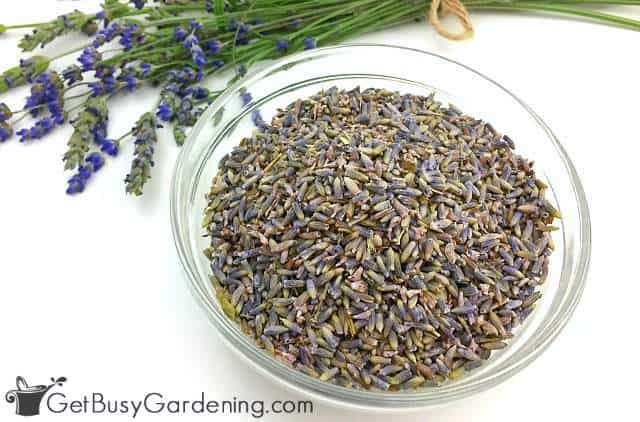
How To Dry Lavender
The steps for drying fresh lavender are the same whether you want to use the leaves or the flowers. The first step is making sure you know how to cut it for drying.
So, in this section, I’ll talk about how to cut the flowers and leaves for drying. Then in the next section, I’ll talk in detail about the different methods for drying them.
Related Post: How To Propagate Lavender Plants From Cuttings
Drying Lavender Flowers
You can either cut the flowers at the base of the stem, right above the leaves. Or you can cut them just below the buds, depending on your intended use and method of drying.
Don’t attempt to remove the buds before they are dry though, or you could crush them.
To cut lavender flowers for drying, be sure to use a sharp pair of precision pruners to snip off the stalks, rather than picking or breaking them off.
Related Post: Lavender Cookies Recipe (Using Dried Or Fresh Buds)

Drying Lavender Leaves
Lavender leaves smell wonderful, and are just as easy to dry as the flowers. For best results, use the tender new growth that is at the tips of the stems.
You can cut the leaves at any time. But, if you don’t want to sacrifice the flowers, then wait until the stem is done blooming before cutting it. Or, you could simply pluck off the individual leaves, if you prefer.
Just make sure you don’t cut the branches too far down on the plant, or they may not grow back. Learn how to properly prune lavender here.
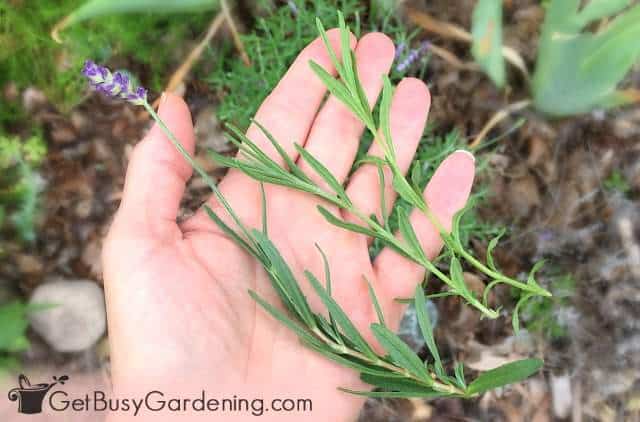
Best Way To Dry Lavender
The exact steps for how to dry lavender depend on the method you use. There are several methods to choose from, and all of them are pretty easy.
You can use any of these methods whether you want to dry the flowers or the leaves.
Choose the one that’s the most convenient, or experiment with a few to see which one works the best for you.
Below are the best ways to dry lavender, along with step-by-step instructions for each method…
Hanging Lavender To Dry
One of the easiest ways to dry out fresh lavender is to hang it upside down. If you chose to use this method, make sure your bundles are small, and bunch them loosely to prevent mildew.
It can take a week or more for it to dry when you hang the bunches upside down, depending on how humid it is.
Here are the steps for how to hang lavender to dry…
- Once you have a nice bunch of lavender stems (10-15 stems), bundle them into a bouquet.
- Tie the base of the stems using twine or string, leaving one end long for hanging. You could also buy a cute hanging rack that’s made for drying bunches of herbs.
- Hang the bundles in a cool, dry location protected from sunlight (the sun will fade the color). I like to hang mine in my kitchen or in the garage.
- Check the bundles every few days to ensure they are drying, and not molding
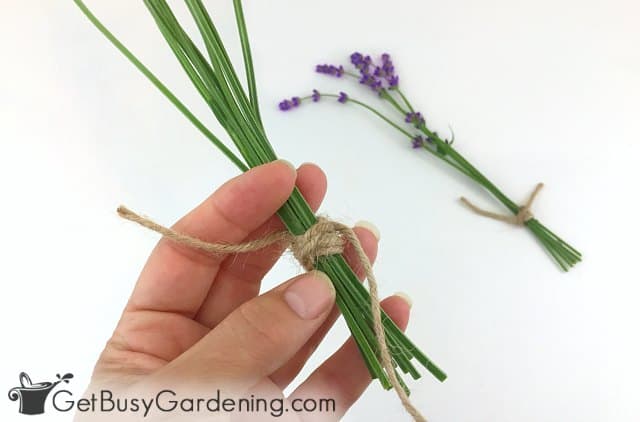
Using A Drying Rack
Another great way to dry lavender buds or leaves is to use a hanging herb drying rack. If you have the space, you can use a kitchen counter drying tray instead.
You could try spreading the stems out on paper towels and leaving them out on the counter, which will also work. But it may take a little longer for them to dry.
It usually takes a several days for lavender to dry using this method. The looser you lay them, the faster they will dry.
Here are the steps for using a drying rack…
- Lay the stems on the rack so that none of them are touching, rather than piling them on top of each other
- Place the drying rack in a cool, dry, and dark location that gets good air circulation
- Check them every few days to ensure they aren’t molding, and to test for dryness
Dehydrating Lavender
Using a food dehydrator is an easy way to dry lavender fast. It only takes a few hours using a dehydrator, and you don’t have to worry about burning it like you would in the oven or microwave.
Here are the steps for how to dry lavender in a dehydrator…
- Spread the stems out on the dehydrator sheets or trays, and place them into the dehydrator
- Set it to the lowest setting (my dehydrator has a setting for herbs, which is what I use)
- Check it every hour, and remove it from the dehydrator once it’s completely dry
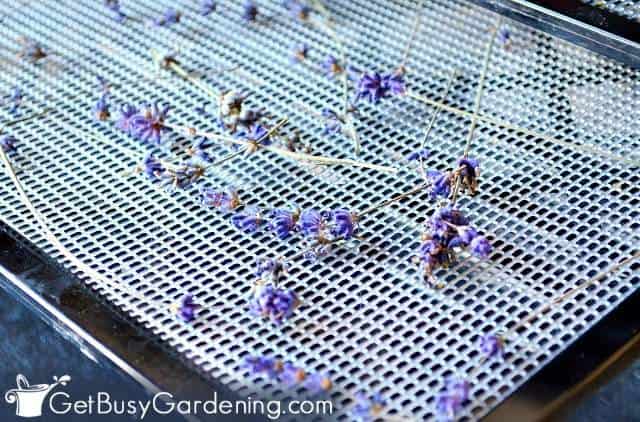
Drying Lavender In The Oven
Another great way to dry lavender quickly it to use your oven. It doesn’t take very long to dry it in the oven, so make sure to keep a close eye on it. If you leave it in for too long, you can burn it.
Here are the steps for how to dry lavender in the oven…
- Preheat your oven to it’s lowest setting (I use 200F for mine)
- Spread the lavender out on an ungreased cookie sheet, and place it into the oven
- Check it every 10 minutes, and remove it from the oven as soon as it’s dry
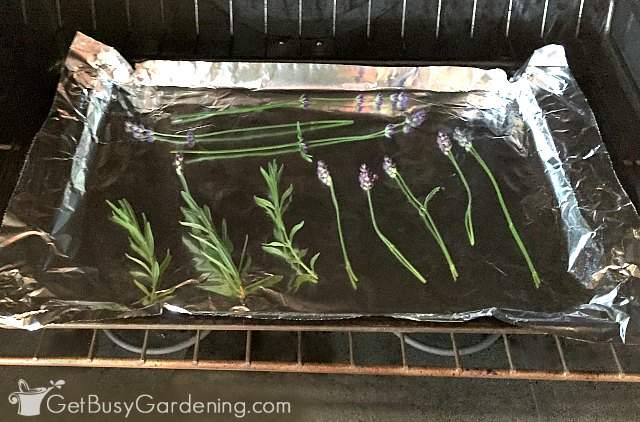
Drying Lavender In The Microwave
Yes, you can dry your lavender in the microwave. But, just like using the oven, you can overdo it. So, take care not to run your microwave for too long.
Here’s how to dry lavender in the microwave…
- Spread the lavender on a paper plate or a towel
- Run the microwave for one minute, then check for dryness
- Continue running the microwave in 15-20 second bursts, checking for dryness between each run
Related Post: How To Grow Lavender From Seed & When To Plant
How To Store Dried Lavender
It’s important to make sure your lavender is completely dry before storing it. You’ll know it’s dry when the flowers and leaves are brittle, and fall off the stem easily when disturbed.
You can remove the dried buds from the stems by gently running your fingers along the stem. Otherwise, you can just store the fresh dried stems whole.
I like to store mine in a clear mason jar because it looks pretty in my pantry. But, you could store it in decorative canisters, a paper bag, spice jars, or any other container you want.
Whatever container you choose to use, just be sure to store it in a cool, dry and dark location.
Related Post: How To Collect Lavender Seeds From Your Garden

How Long Does Dried Lavender Last?
You can keep dried lavender for many years, it never goes bad. But the smell will fade over time.
So, for the freshest, most fragrant supply, I recommend drying it every year, and discarding your old stash. Otherwise, you can try adding a few drops of lavender essential oil to refresh the scent.
Drying lavender is easy, and doesn’t take much time. Experiment with the different ways to dry it, and choose the method that works the best for you. Soon you’ll have a constant supply of dried lavender to use anytime you need it.
More Food Preservation Posts
- 9 Easy Ways To Preserve Fresh Garden Herbs
- How To Freeze Herbs Fresh from Your Garden
- How To Dry Oregano At Home In 4 Different Ways
- How To Dry Basil (5 Best Ways)
- Freezing Fresh Chives The Right Way
- How To Dehydrate Apples: 5 Simple Drying Methods
Leave a comment below to share your favorite method, or add your tips for how to dry lavender.
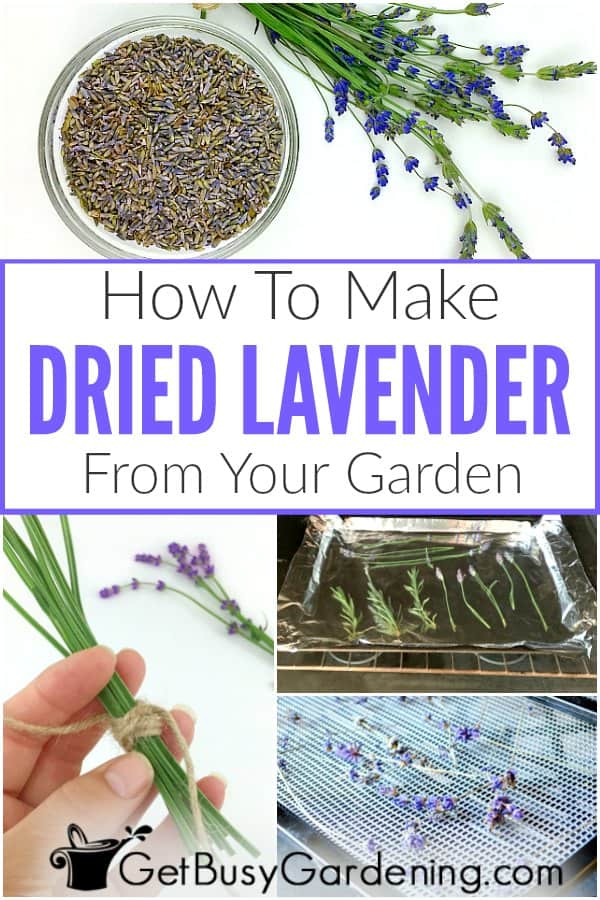
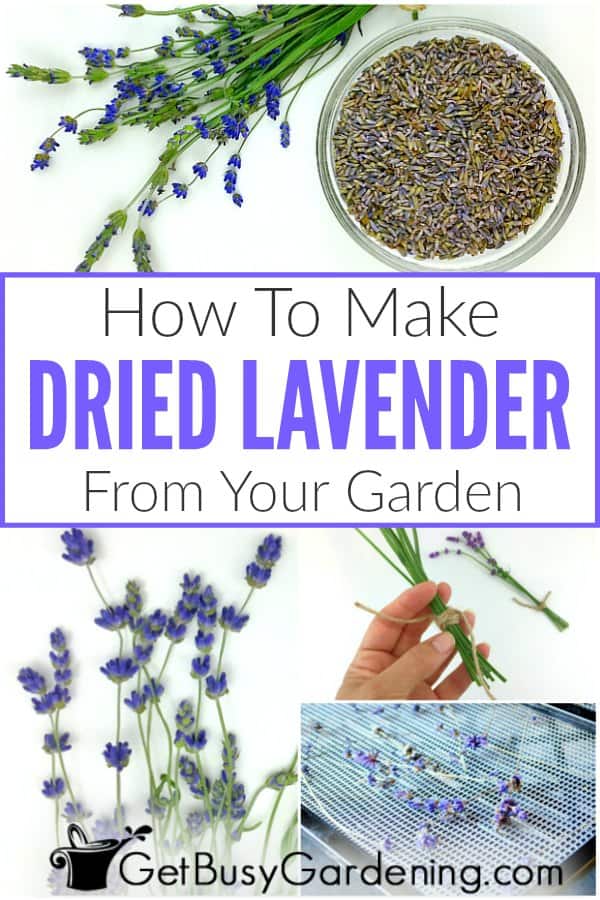


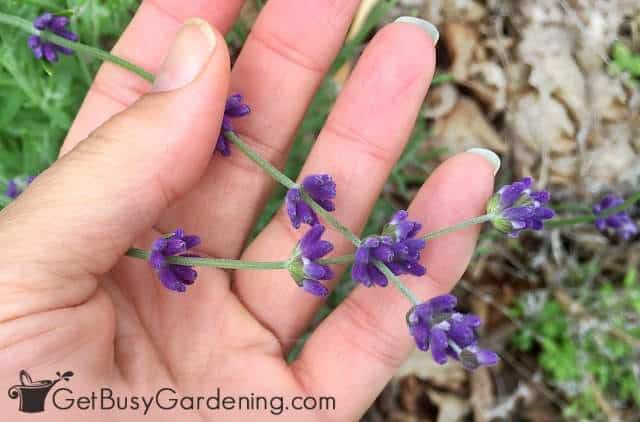

Emmy says
Just discovered that I have a wealth in my garden for the last 50 years and never knew it. I tried the lavender tea and am most impressed. Will now dry this season crop and make biscuits next. So greatful I found this article and tried it out.
Amy Andrychowicz says
Wow, that is fantastic! It’s so easy to dry lavender, and there are so many great uses for it! I also have a yummy recipe you can try here… Lavender Cookies Recipe. Enjoy!
Stephanie says
Just tried this recipe with lavender picked yesterday, dried in the microwave last night and made the cookies this afternoon. The lavender was overpowering. Next time I will half the amount of lavender.
Good cookie. As a side note I made this with cannabutter for my husband’s bad knees. He loved the freshness and the shortbread. Said he couldn’t taste the “earthiness” of the cannabutter.
Amy Andrychowicz says
Yes, freshly dried lavender will be much more potent than the older stuff that you get from the store. So it is a good idea to experiment with the amount you use in your recipes. Thanks for bringing that up. 🙂 Here’s my cookie recipe if you want to give it a try, it’s delicious!!
Renee says
Hi Amy!
I inherited several lavender plants that have gotten woody. How should I prune them back to shape?
Amy Andrychowicz says
Wonderful! You can follow my step by step instructions located here… Pruning Lavender: A Step-By-Step Guide.
Pauline Francis says
I have English Lavender growing in my garden, will try drying this year. As for baking can you use this type of Lavender?
Amy Andrychowicz says
Yes! In fact, English lavender has the best fragrance and flavor after drying.
Judy D.jA says
I have 3 good size lavender plants that never flowered. I would like to dry the leaves but don’t know what to use them for.
Amy Andrychowicz says
You can use dried lavender leaves just like you would the flowers – in teas, baking, cooking…etc. They smell wonderful, but do have a slightly different flavor than the flowers.
Melissa says
Can I leave a fresh cut bouquet of lavender in a vase to dry?
Amy Andrychowicz says
You sure could, but it’s better to dry lavender bouquets upside down. Otherwise, gravity will make the flowers droop, and they won’t be as nice looking.
Jacinta says
Lavender is so versatile. Loved your post.
Thanks for sharing
Amy Andrychowicz says
Yes, lavender is wonderful! 🙂 You’re welcome, glad you enjoyed it.
Maddie says
This was so helpful! Thank you!!
Amy Andrychowicz says
You’re welcome!
fumiko mehl says
your plant website is very nice. I am glad I find your website.
there is not many website about how to get seeds from plants. The majority is just for how to grow plants.
I got your chive and lavender seed collection articles.
I plant herbs every year but they don’t self seeding on the ground any more in the succeeding year.
Amy Andrychowicz says
Wonderful, you’re welcome! Good luck with your herb garden. 🙂
Kirsty says
I like to dangle a small bunch of 5-10 flowers/buds infront of the heater. Rotating the bunch every 15mins or so until dry….. makes the house smell lavendery lovely almost instantly. I’m from Adelaide, South Australia. ???????
Amy Andrychowicz says
Great idea for drying your lavender flowers. I bet the house smells amazing!
Licia Stazzonelli says
Love your page and instructions .
I have a question from Fremantle -western Australia.
Why does my lavender turn grey and does not keep its purple colour
Than you
Amy Andrychowicz says
Dried lavender flowers will lose most of their color when dried, that is normal. They won’t stay the bright purple they were when fresh.
Vanessa Bowman says
When you cook with lavender i.e. cookies or pie do you just use the dried flowers? Also for teas? Storing lavender in jars sounds fantastic too. Is that also just the flowers or stems and flowers?
Sorry just a little confused about what parts to use – stems, leaves, flowers…
Thanks,
Vanessa
Amy Andrychowicz says
No worries, it’s a common question! 🙂 Most people use lavender flower buds for cooking and teas, but you could use the leaves too. You can cook, bake, and make tea using either fresh or dried lavender. Fresh lavender has a stronger fragrance and flavor. So, you should use less in your recipes and tea if it’s fresh than if it’s dried. Hope this clears things up for you.
Lavender cookies sound amazing by the way!
PlantPostings says
This is great, Amy. Thanks! I’ve had Lavendar in my garden in the past when I had more sun. If I grow it again, I’ll plan to store it in mason jars–good idea!
Amy Andrychowicz says
Thanks! My lavender plans are definitely much happier now that I moved them to a sunnier spot. Glad you like my mason jar storage idea! 🙂
Barbara Dorsey says
I have about 500 stems of dried lavender and need to make about 20 mini bouquets to lay on a table of a rehearsal dinner. I would like to use raffia paper ribbon to tie, and would love some suggestions on the best way to go about making these. Thank you!
Amy Andrychowicz says
What a cute for using dried lavender stems! I think that bundling the stems and tying them with the ribbon would work great. You could also buy some small rubber bands to hold them together better if you’re worried the ribbon won’t hold on it’s own. Have fun!